人教版七年级下册 Unit 6 I'm watching TV. Section A 1a-2c 课件 (共54张PPT)
文档属性
| 名称 | 人教版七年级下册 Unit 6 I'm watching TV. Section A 1a-2c 课件 (共54张PPT) | 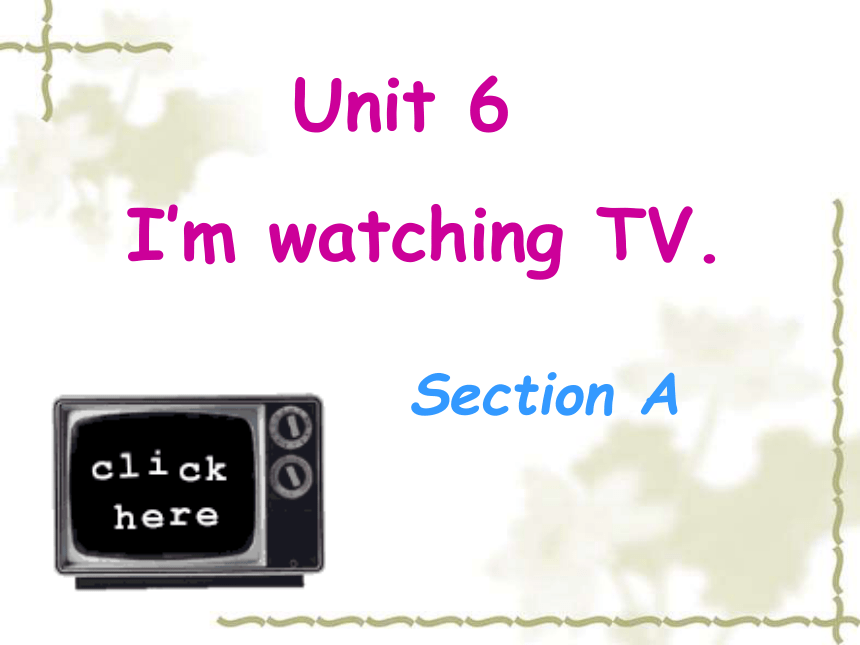 | |
| 格式 | ppt | ||
| 文件大小 | 2.7MB | ||
| 资源类型 | 教案 | ||
| 版本资源 | 人教新目标(Go for it)版 | ||
| 科目 | 英语 | ||
| 更新时间 | 2023-01-12 21:54:06 | ||
图片预览

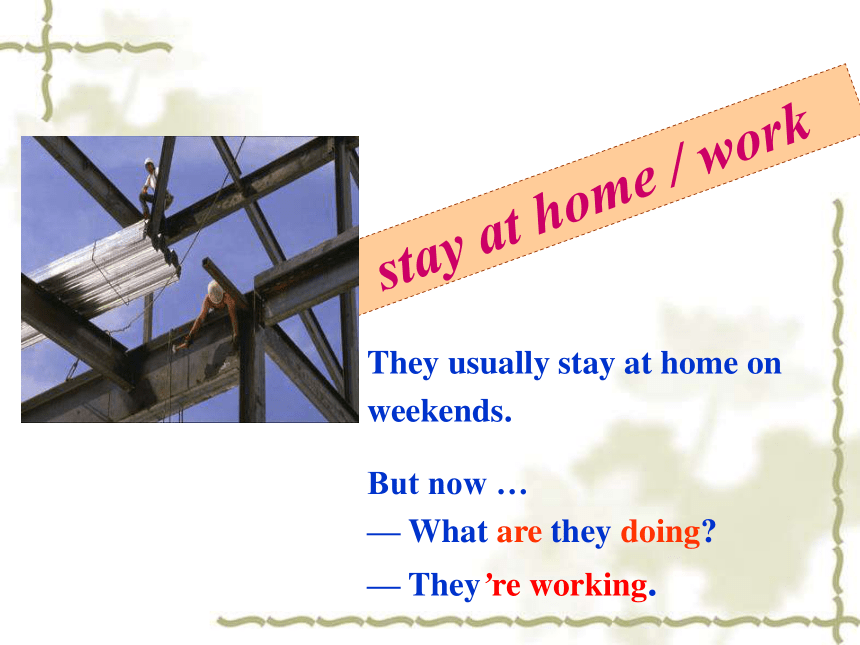
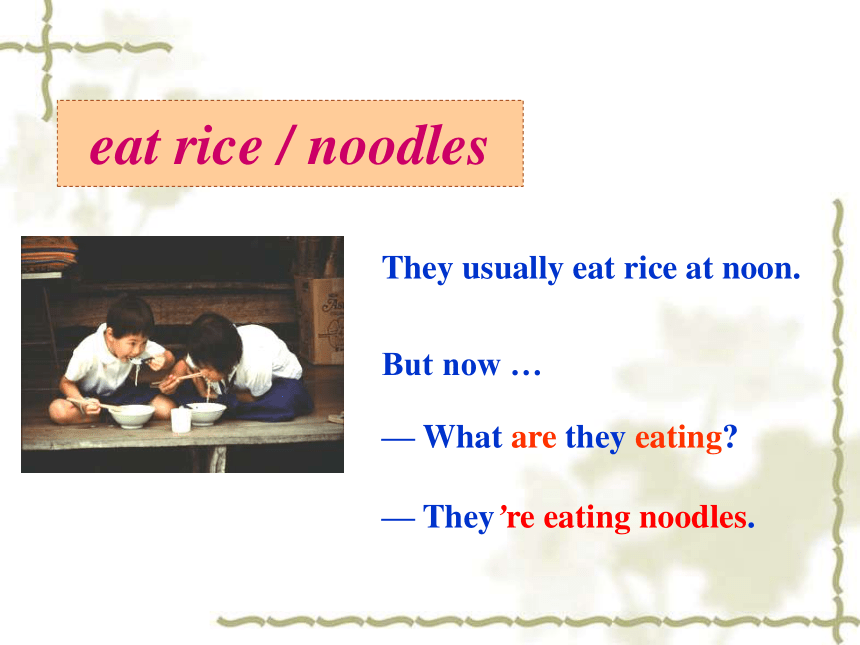

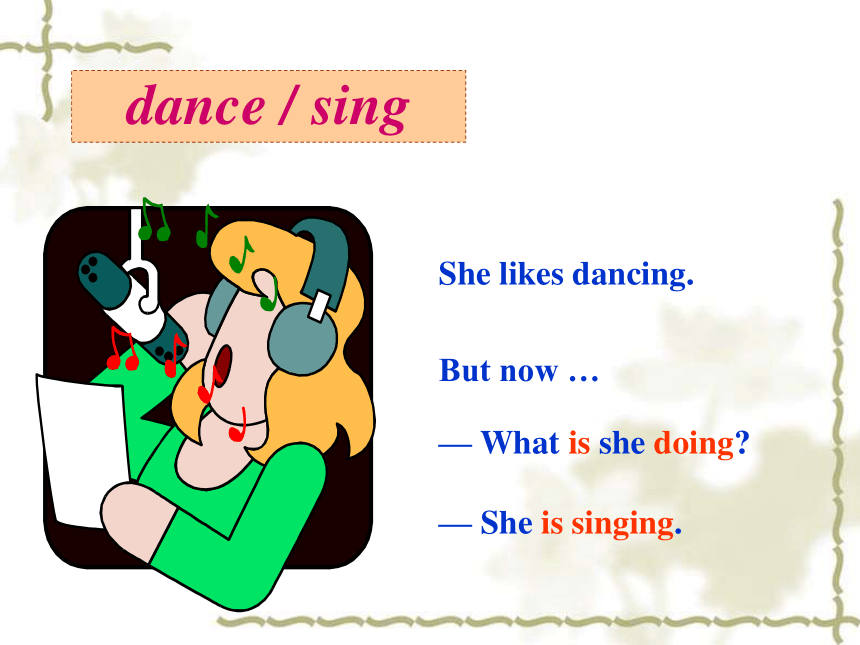
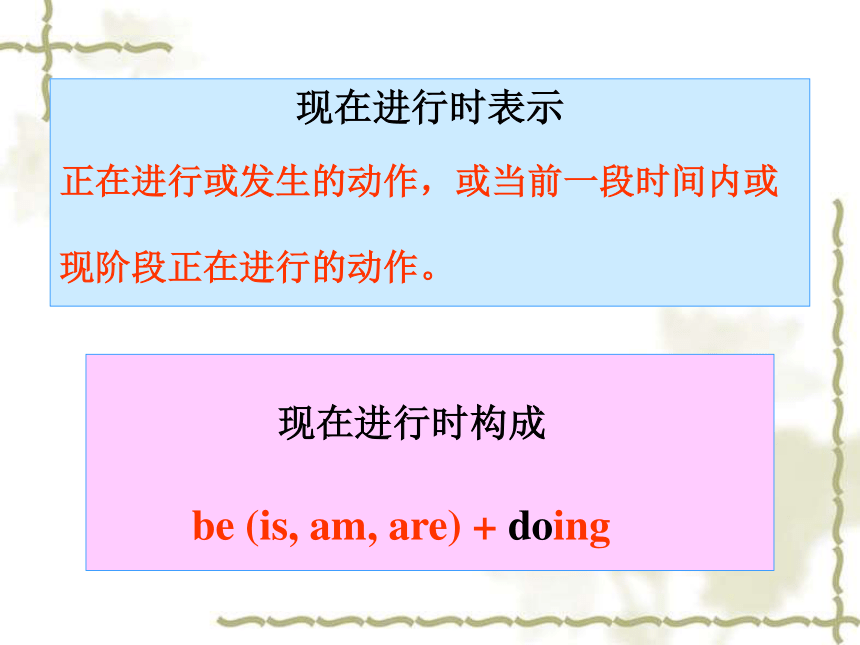
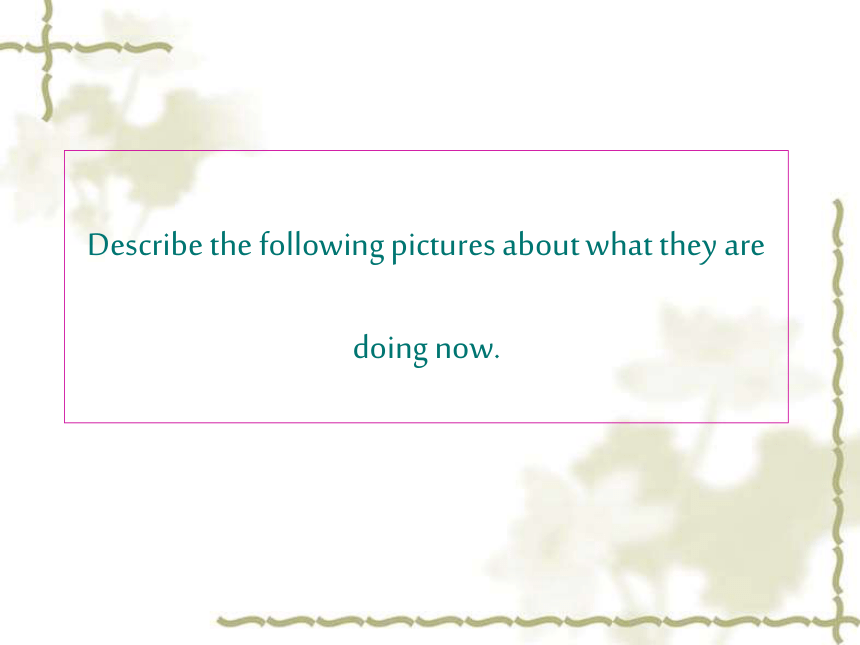


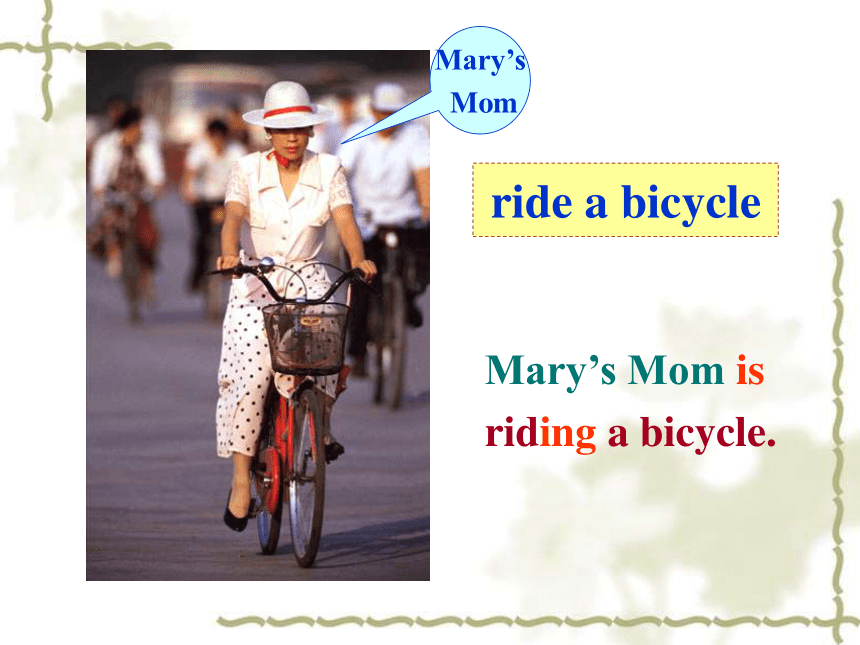
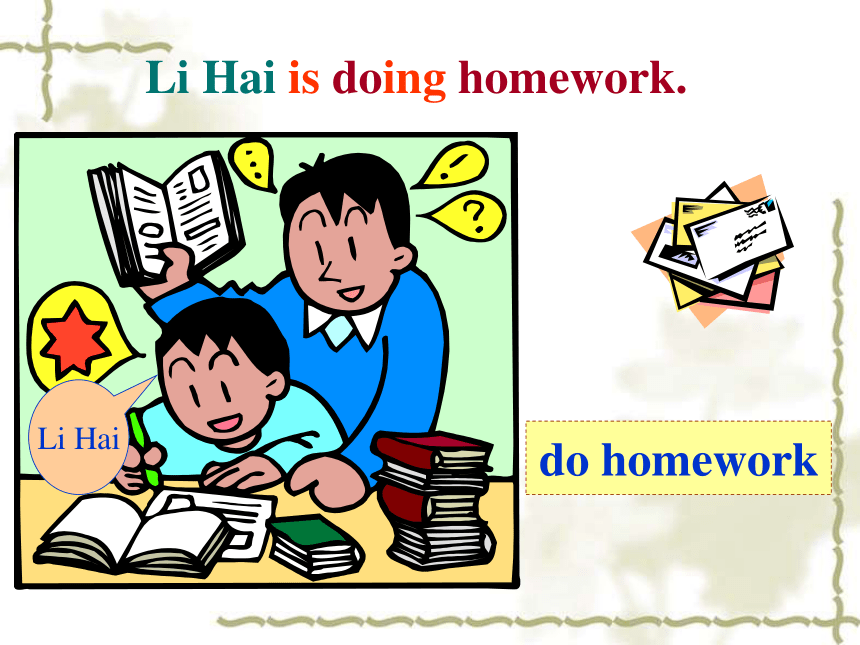
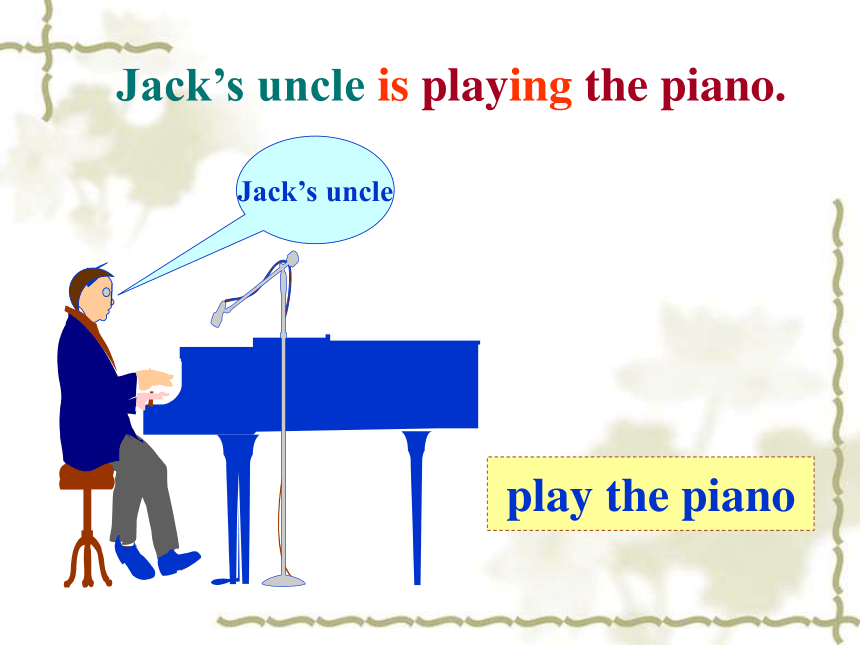
文档简介
(共54张PPT)
Unit 6
I’m watching TV.
Section A
stay at home / work
They usually stay at home on weekends.
But now …
— What are they doing
— They’re working.
eat rice / noodles
They usually eat rice at noon.
But now …
— What are they eating
— They’re eating noodles.
swim / play baseball
He usually swims after work.
But now …
— What is he doing
— He is playing baseball.
dance / sing
She likes dancing.
But now …
— What is she doing
— She is singing.
现在进行时表示
正在进行或发生的动作,或当前一段时间内或现阶段正在进行的动作。
现在进行时构成
be (is, am, are) + doing
Describe the following pictures about what they are doing now.
swim
They’re swimming.
run
They’re running.
Mary’s
Mom
ride a bicycle
Mary’s Mom is
riding a bicycle.
Li Hai
do homework
Li Hai is doing homework.
Jack’s uncle
play the piano
Jack’s uncle is playing the piano.
A: What are you doing
B: I am cleaning.
A: What’s he doing
B: He’s reading.
A: What are they doing
B: They are watching TV.
Read together.
Pairwork: Ask and answer questions about what people are doing in the following pictures.
Read the dialogues together.
A: Is he doing homework
B: Yes, he is.
A: Is she reading a book
B: No, she isn’t. / No, she is reading the newspaper.
A: Are you drawing a picture
B: Yes, I am. / No, I’m not (drawing a picture).
A: Are they eating breakfast
B: Yes, they are. / No, they aren’t. They are talking.
— What is it playing
— Is it playing the trumpet
— No, it isn’t. It isn’t playing
the trumpet.
— It’s playing the saxophone.
— What are you doing
— Are you doing homework
— I’m playing computer
games.
— No, I’m not. I’m not doing homework.
— Are they singing
— What are they doing
— No, they aren’t.
They aren’t singing.
— They are dancing.
2c: Pairwork
A: Is Nancy doing her homework
B: No, she isn’t. She is writing a letter.
A: Is Mary writing a letter
B: No, she isn’t. She’s looking at a bird.
A: Is Tom drawing a picture
B: Yes, he is.
A: Is Bill reading a book
B: No, he isn’t. He’s eating.
A: Is Nancy doing her homework
B: No, she isn’t. She is writing a letter.
— Is Mr Smith drawing a picture
— Yes, he is.
Mr Smith
— What is John doing
— He is writing.
— Is his sister writing
— No, she isn’t writing. She is reading.
— The musician is playing
the trumpet.
— What is the musician playing
现在进行时
肯定句:主语 + be + 动词的现在分词(-ing)
I / you / he / she / it
we / you / they / …
am / is
/ are
否定句:主语 + be + not + 动词的现在分词(-ing)
一般疑问句:be +主语 + 动词的现在分词(-ing)
特殊疑问句:特殊疑问词 + be +主语 + 动词的现在分词(-ing)
Ask and answer questions about
what’s happening in the pictures.
steal v. 偷 stealing n.
wait for 等待
catch 抓
tell sb. about sth. 告诉某人某事
take sb. to a place 带某人到某地儿
at the bus stop 在公交车站
thief 小偷;贼
policewoman 女警察
police station 警察局
Pairwork
Where is the man
He is in a supermarket.
What’s he taking
He is taking some drinks.
A man is stealing in a supermarket.
What’s he waiting for
He is waiting for the bus.
What’s he reading
He’s reading a newspaper.
The thief is reading a newspaper
and waiting for the bus.
Pairwork
Who are Ben and Tom talking to
They are talking to a policewoman.
What are they talking about
They are talking about the stealing.
Ben and Tom is talking to a policewoman
about the stealing.
Pairwork
Where are they all going
They are all going to police station.
What’s the man doing
The man is talking to himself.
The policewoman and the children
are taking the thief to the police station.
Pairwork
请把下列动词变成现在分词形式。
play
win
dance
run
lie
open
make
die
see
come
walk
study
eat
begin
playing
winning
dancing
running
lying
opening
making
dying
seeing
beginning
eating
studying
walking
coming
规则 动词原形 -ing形式
一般在动词原形末尾加-ing go, ask, fly going, asking flying
以不发音字母e结尾的动词,去e加-ing write, make, take writing, making, taking
以重读闭音节结尾且末尾只有一个辅音字母的动词,则双写该辅音字母再加-ing get, sit, put, run, begin getting, sitting, putting, running, beginning
以ie结尾的动词,应把ie变为y,再加-ing die, tie, lie dying, tying, lying
1. do (one’s) homework 做作业
homework为不可数名词。例如:
I have much homework to do today.
今天我有许多作业要做。
one’s 代表物主代词,要和主语保持一致。例如:
We do our homework in the evening.
我们在晚上做作业。
He often does his homework at home.
他经常在家做作业。
Language points of Section A
He doesn’t often do his homework at home.一句的
疑问句和否定句:
Does he often do his homework at home (疑问句)
He doesn’t often do his homework at home.(否定句)
1) watch 意为“观看”。指长时间地观赏或注视,如: 看电视、比赛、表演及赏月等。例如:
He likes watching TV.
他喜欢看电视。
2. watch, see, look, read的区别:
2) read 意为“看;读”。其宾语常是和文字相关的书、 报、杂志等。例如:
He is reading a book.
他正在看书。
3) 意为“看”,强调动作,不注重结果。是不及物动词,
带宾语时要加at。例如:
Look. There is a boy under the tree.
看,树下有一个男孩。
Please look at the blackboard.
请看黑板。
4) see强调“看”的结果是看见还是没看见。也指看电影 (see a film)、看病(see a doctor)等。例如:
I can see some birds in the tree.
我能看见树上有一些鸟。
3. clean
1) adj. 干净的
The desk is clean.
桌子很干净。
2) v. 扫除;清除
He is cleaning his room.
他正在打扫房间。
4. eat dinner 吃晚饭
一日三餐breakfast, lunch和dinner前通常不使用冠词。例如:
make / prepare dinner 做晚餐/准备晚餐
但当dinner前面有形容词修饰时,有时加上冠词,有时变为复数。例如:
I’ve cooked a nice dinner.
我做好了一顿可口的晚餐。
dinner侧重表示盛宴或派对时,前面也可以加冠词。例如:
hold a dinner 举行晚宴
5. want to do sth. 想要做某事
want sb. to do sth. 想让某人做某事
Do you want to go to the movies
你想去看电影吗?
I want Andrew to sing with me.
我想让安德鲁和我一起唱。
6. write a letter 写信
write a letter to sb. = write to sb. 给某人写信
I often write letters to my friend.
= I often write to my friend.
我经常给朋友写信。
7. Sure. 当然。
用来表示同意对方的请求或建议。例如:
— May I have a look
我可以看一看吗?
— Sure.
当然。
8. Let’s + 动词原形
表示建议,意为“让我们做……吧!”。let’s = let us
例如:
Let’s see the tigers first.
让我们先看老虎吧。
Let + 代词宾格 + do sth.
Let me help you. 让我来帮助你吧。
Let + 宾语 + not do sth.
Let’s not disturb him.
让我们不要打扰他了。
9. wait 等;等候
wait是不及物动词,后面接宾语时须加介词for,
即:
wait for sb. / sth. 例如:
He is waiting for a bus.
他正在等一辆公共汽车。
Are you waiting for me
你在等我吗?
10. all 全部;全都;所有的
指三者及三者以上。通常放在助动词后,实义动词前。
例如:
We are all students. 我们全都是学生。
They all work hard. 他们全都努力学习。
All也可以放在句首,修饰名词。例如:
All the students are here.
所有的学生都在这儿。
根据中文补全句子。
1. 爷爷奶奶正在看电视。
My grandparents ________ ________ ________.
2. 南茜在写信吗?
________ Nancy ________ a letter
3. 本正在跟谁说话?
Who is Ben ________ ________
4. 小偷在等什么?
What’s the thief ________ ________
5. 我正和朋友电话聊天。
I ________ ________ with my friend ________
the phone.
are
Is
writing
talking
to
waiting
for
am
talking
on
watching
TV
根据要求变化句子。
1. Steve is watching TV. (就画线部分提问)
2. Dave and his brother are playing computer
games. (变为一般疑问句)
What is Steve doing
Are Dave and his brother playing computer
games
3. I am catching a thief. (变为否定句)
4. are, we, teacher, talking, about, to, test, the, our (连词成句)
I am not catching a thief.
We are talking to our teacher about the test.
根据要求变化句子。
Unit 6
I’m watching TV.
Section A
stay at home / work
They usually stay at home on weekends.
But now …
— What are they doing
— They’re working.
eat rice / noodles
They usually eat rice at noon.
But now …
— What are they eating
— They’re eating noodles.
swim / play baseball
He usually swims after work.
But now …
— What is he doing
— He is playing baseball.
dance / sing
She likes dancing.
But now …
— What is she doing
— She is singing.
现在进行时表示
正在进行或发生的动作,或当前一段时间内或现阶段正在进行的动作。
现在进行时构成
be (is, am, are) + doing
Describe the following pictures about what they are doing now.
swim
They’re swimming.
run
They’re running.
Mary’s
Mom
ride a bicycle
Mary’s Mom is
riding a bicycle.
Li Hai
do homework
Li Hai is doing homework.
Jack’s uncle
play the piano
Jack’s uncle is playing the piano.
A: What are you doing
B: I am cleaning.
A: What’s he doing
B: He’s reading.
A: What are they doing
B: They are watching TV.
Read together.
Pairwork: Ask and answer questions about what people are doing in the following pictures.
Read the dialogues together.
A: Is he doing homework
B: Yes, he is.
A: Is she reading a book
B: No, she isn’t. / No, she is reading the newspaper.
A: Are you drawing a picture
B: Yes, I am. / No, I’m not (drawing a picture).
A: Are they eating breakfast
B: Yes, they are. / No, they aren’t. They are talking.
— What is it playing
— Is it playing the trumpet
— No, it isn’t. It isn’t playing
the trumpet.
— It’s playing the saxophone.
— What are you doing
— Are you doing homework
— I’m playing computer
games.
— No, I’m not. I’m not doing homework.
— Are they singing
— What are they doing
— No, they aren’t.
They aren’t singing.
— They are dancing.
2c: Pairwork
A: Is Nancy doing her homework
B: No, she isn’t. She is writing a letter.
A: Is Mary writing a letter
B: No, she isn’t. She’s looking at a bird.
A: Is Tom drawing a picture
B: Yes, he is.
A: Is Bill reading a book
B: No, he isn’t. He’s eating.
A: Is Nancy doing her homework
B: No, she isn’t. She is writing a letter.
— Is Mr Smith drawing a picture
— Yes, he is.
Mr Smith
— What is John doing
— He is writing.
— Is his sister writing
— No, she isn’t writing. She is reading.
— The musician is playing
the trumpet.
— What is the musician playing
现在进行时
肯定句:主语 + be + 动词的现在分词(-ing)
I / you / he / she / it
we / you / they / …
am / is
/ are
否定句:主语 + be + not + 动词的现在分词(-ing)
一般疑问句:be +主语 + 动词的现在分词(-ing)
特殊疑问句:特殊疑问词 + be +主语 + 动词的现在分词(-ing)
Ask and answer questions about
what’s happening in the pictures.
steal v. 偷 stealing n.
wait for 等待
catch 抓
tell sb. about sth. 告诉某人某事
take sb. to a place 带某人到某地儿
at the bus stop 在公交车站
thief 小偷;贼
policewoman 女警察
police station 警察局
Pairwork
Where is the man
He is in a supermarket.
What’s he taking
He is taking some drinks.
A man is stealing in a supermarket.
What’s he waiting for
He is waiting for the bus.
What’s he reading
He’s reading a newspaper.
The thief is reading a newspaper
and waiting for the bus.
Pairwork
Who are Ben and Tom talking to
They are talking to a policewoman.
What are they talking about
They are talking about the stealing.
Ben and Tom is talking to a policewoman
about the stealing.
Pairwork
Where are they all going
They are all going to police station.
What’s the man doing
The man is talking to himself.
The policewoman and the children
are taking the thief to the police station.
Pairwork
请把下列动词变成现在分词形式。
play
win
dance
run
lie
open
make
die
see
come
walk
study
eat
begin
playing
winning
dancing
running
lying
opening
making
dying
seeing
beginning
eating
studying
walking
coming
规则 动词原形 -ing形式
一般在动词原形末尾加-ing go, ask, fly going, asking flying
以不发音字母e结尾的动词,去e加-ing write, make, take writing, making, taking
以重读闭音节结尾且末尾只有一个辅音字母的动词,则双写该辅音字母再加-ing get, sit, put, run, begin getting, sitting, putting, running, beginning
以ie结尾的动词,应把ie变为y,再加-ing die, tie, lie dying, tying, lying
1. do (one’s) homework 做作业
homework为不可数名词。例如:
I have much homework to do today.
今天我有许多作业要做。
one’s 代表物主代词,要和主语保持一致。例如:
We do our homework in the evening.
我们在晚上做作业。
He often does his homework at home.
他经常在家做作业。
Language points of Section A
He doesn’t often do his homework at home.一句的
疑问句和否定句:
Does he often do his homework at home (疑问句)
He doesn’t often do his homework at home.(否定句)
1) watch 意为“观看”。指长时间地观赏或注视,如: 看电视、比赛、表演及赏月等。例如:
He likes watching TV.
他喜欢看电视。
2. watch, see, look, read的区别:
2) read 意为“看;读”。其宾语常是和文字相关的书、 报、杂志等。例如:
He is reading a book.
他正在看书。
3) 意为“看”,强调动作,不注重结果。是不及物动词,
带宾语时要加at。例如:
Look. There is a boy under the tree.
看,树下有一个男孩。
Please look at the blackboard.
请看黑板。
4) see强调“看”的结果是看见还是没看见。也指看电影 (see a film)、看病(see a doctor)等。例如:
I can see some birds in the tree.
我能看见树上有一些鸟。
3. clean
1) adj. 干净的
The desk is clean.
桌子很干净。
2) v. 扫除;清除
He is cleaning his room.
他正在打扫房间。
4. eat dinner 吃晚饭
一日三餐breakfast, lunch和dinner前通常不使用冠词。例如:
make / prepare dinner 做晚餐/准备晚餐
但当dinner前面有形容词修饰时,有时加上冠词,有时变为复数。例如:
I’ve cooked a nice dinner.
我做好了一顿可口的晚餐。
dinner侧重表示盛宴或派对时,前面也可以加冠词。例如:
hold a dinner 举行晚宴
5. want to do sth. 想要做某事
want sb. to do sth. 想让某人做某事
Do you want to go to the movies
你想去看电影吗?
I want Andrew to sing with me.
我想让安德鲁和我一起唱。
6. write a letter 写信
write a letter to sb. = write to sb. 给某人写信
I often write letters to my friend.
= I often write to my friend.
我经常给朋友写信。
7. Sure. 当然。
用来表示同意对方的请求或建议。例如:
— May I have a look
我可以看一看吗?
— Sure.
当然。
8. Let’s + 动词原形
表示建议,意为“让我们做……吧!”。let’s = let us
例如:
Let’s see the tigers first.
让我们先看老虎吧。
Let + 代词宾格 + do sth.
Let me help you. 让我来帮助你吧。
Let + 宾语 + not do sth.
Let’s not disturb him.
让我们不要打扰他了。
9. wait 等;等候
wait是不及物动词,后面接宾语时须加介词for,
即:
wait for sb. / sth. 例如:
He is waiting for a bus.
他正在等一辆公共汽车。
Are you waiting for me
你在等我吗?
10. all 全部;全都;所有的
指三者及三者以上。通常放在助动词后,实义动词前。
例如:
We are all students. 我们全都是学生。
They all work hard. 他们全都努力学习。
All也可以放在句首,修饰名词。例如:
All the students are here.
所有的学生都在这儿。
根据中文补全句子。
1. 爷爷奶奶正在看电视。
My grandparents ________ ________ ________.
2. 南茜在写信吗?
________ Nancy ________ a letter
3. 本正在跟谁说话?
Who is Ben ________ ________
4. 小偷在等什么?
What’s the thief ________ ________
5. 我正和朋友电话聊天。
I ________ ________ with my friend ________
the phone.
are
Is
writing
talking
to
waiting
for
am
talking
on
watching
TV
根据要求变化句子。
1. Steve is watching TV. (就画线部分提问)
2. Dave and his brother are playing computer
games. (变为一般疑问句)
What is Steve doing
Are Dave and his brother playing computer
games
3. I am catching a thief. (变为否定句)
4. are, we, teacher, talking, about, to, test, the, our (连词成句)
I am not catching a thief.
We are talking to our teacher about the test.
根据要求变化句子。
同课章节目录
- Unit 1 Can you play the guitar?
- Section A
- Section B
- Unit 2 What time do you go to school?
- Section A
- Section B
- Unit 3 How do you get to school?
- Section A
- Section B
- Unit 4 Don't eat in class.
- Section A
- Section B
- Unit 5 Why do you like pandas?
- Section A
- Section B
- Unit 6 I'm watching TV.
- Section A
- Section B
- Review of Units 1-6
- Unit 7 It's raining!
- Section A
- Section B
- Unit 8 Is there a post office near here?
- Section A
- Section B
- Unit 9 What does he look like?
- Section A
- Section B
- Unit 10 I'd like some noodles.
- Section A
- Section B
- Unit 11 How was your school trip?
- Section A
- Section B
- Unit 12 What did you do last weekend?
- Section A
- Section B
